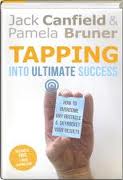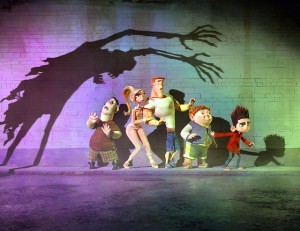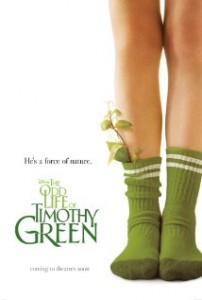Jack Canfield , co-author of over 200 “Chicken Soup for the Soul” books, talked to me about his latest book, Tapping Into Ultimate Success: How to Overcome Any Obstacle and Skyrocket Your Results
, co-author of over 200 “Chicken Soup for the Soul” books, talked to me about his latest book, Tapping Into Ultimate Success: How to Overcome Any Obstacle and Skyrocket Your Results , written with Pamela Bruner. It is literally about transforming your life by adapting ancient techniques of acupuncture to reprogram the thoughts and fears that keep you from achieving your goals. It was fascinating to talk to him about his work and his ideas. I have one copy of the book and DVD to give away. Send me an email at moviemom@movieom.com with “Tapping” in the subject line and don’t forget your address (US addresses only). I’ll pick a winner on August 12.
, written with Pamela Bruner. It is literally about transforming your life by adapting ancient techniques of acupuncture to reprogram the thoughts and fears that keep you from achieving your goals. It was fascinating to talk to him about his work and his ideas. I have one copy of the book and DVD to give away. Send me an email at moviemom@movieom.com with “Tapping” in the subject line and don’t forget your address (US addresses only). I’ll pick a winner on August 12.
Tell me how you and Pamela Bruner divided up the writing and how you worked together.
Jack: Sometimes I take the first draft because it’s a topic I’m more familiar with and more of an expert on, and the other person will, depending on what I’ve written, sometimes will do one chapter, and she’ll do another, and with this one, I had written The Success Principles , and what we were finding was a lot of the people were understanding the principles, championing the principles, but somehow they weren’t getting the success they wanted and so, started looking at what are the underlying psychological blocks that block people and discovered the fears and limiting beliefs that are below the threshold of consciousness. Pamela Bruner, who’s a tapping expert, knew a whole lot about how to break through those blocks and she was one of my students and was applying her own technology of tapping to the success principles that I was teaching. She went from making about $3000 a month to, she’ll make a million dollars this year, and that’s in three years, so, she really had major breakthroughs. We started saying, “Well, let’s collaborate,” so she took the success principles and we rewrote some of them and she added the tapping scripts to them and so the book went back and forth. She’d send me a chapter, I’d edit it, I’d send her a copy, she’d edit it, and we’d integrate it and get on the phone and talk about it and little by little the book came to be.
, and what we were finding was a lot of the people were understanding the principles, championing the principles, but somehow they weren’t getting the success they wanted and so, started looking at what are the underlying psychological blocks that block people and discovered the fears and limiting beliefs that are below the threshold of consciousness. Pamela Bruner, who’s a tapping expert, knew a whole lot about how to break through those blocks and she was one of my students and was applying her own technology of tapping to the success principles that I was teaching. She went from making about $3000 a month to, she’ll make a million dollars this year, and that’s in three years, so, she really had major breakthroughs. We started saying, “Well, let’s collaborate,” so she took the success principles and we rewrote some of them and she added the tapping scripts to them and so the book went back and forth. She’d send me a chapter, I’d edit it, I’d send her a copy, she’d edit it, and we’d integrate it and get on the phone and talk about it and little by little the book came to be.
How did you first learn about tapping?
I first learned about something called “the five minute phobia cure” which was the source of where tapping came from, from a man named Roger Callahan. He was claiming that he could cure 99.4% of all phobias in five minutes or less. My whole attachment to the work I do is how to go further and faster with less effort, so I thought, “Wow, get rid of a phobia in five minutes? People sometimes have these things for years, fear of flight, fear of fire, whatever,” and so I called him up. We talked, he sent me some material, I started to apply it, he sent me more books and videos and so forth and I became really good at it. I could take a whole audience of 600 people and within five minutes or less remove their phobias, their fears, their anxieties, whatever. And then a guy named Gary Craig came a long and he took it, actually simplified it, made it a little easier to apply, made it less esoteric, and now people have taken it and adapted it and added to it and changed it and continually evolved it, but I learned about it from him—and then when Pamela started being my student, we just really hit it off and she taught me a lot of nuances and things I didn’t know from this evolution that had happened since the five-minute phobia cure.
It’s very interesting to me than an important part of this process is accepting yourself, when in fact, what you’re really trying to do is change yourself. Why is it so important to begin by accepting yourself?
You can’t heal what you don’t acknowledge. I use the metaphor that we’re all diamonds, and then there’s a ball of manure around the diamond and then we don’t want to deal with the manure so we put a layer of nail polish over that so we’re two layers removed from what’s really going on. So, we have to acknowledge that there’s fear, acknowledge that there’s limiting belief. Then, as we’re focusing on it, we can break down the patterns that are holding that fear or that negative limiting belief in place. If you just do positive affirmations, it’s kind of putting a smiley face over the gas gauge on your car that’s reading empty; it still reads empty. So, we have to acknowledge that it’s empty so we can deal with the facts and get some gas.
Another thing that surprised me a little bit was the idea of humor or humorous exaggeration, because I would think that would maybe take you out of the moment. Why does that work so effectively?
You know, I’m not really sure. I know that humor, when you laugh and when you take a 25 percent different angle or something, maybe a little funny, that there are actually chemicals secreted in the brain. In fact, I was just at a lecture this weekend where someone was stating that when you laugh, when you have good sex (and she was a couple’s relationship therapist, she would talk about sex and laughter) they both stimulate some of the same hormones of pleasure in the brain. And I think what happens when I use it in my work with tapping is that I’ll have someone, they’re tapping on “It’s not okay to take a risk,” let’s say, “with a man,” you know, they’ve been hurt, let’s say, in a relationship, and so now I’ll be going, “Well, it’s not safe to reach out, I better stay in here, I’m safer in here, but I’d really like to meet a man, there are some cool men out…no, no, that’d be too scary,” and you just kind of play back and forth between these two opposites and in that process, something starts to pop. I can’t give you a solid scientific or psychological rationale for it but whenever I do it, whenever I get to that place you can see the person start to shift, their physiology shifts, and now you know you’re moving toward the positive and implanting that rather than removing the negative. What I do in my tapping is once we’ve removed the fear or limiting belief, I’ll then have that chance to put in a positive belief, you know, “I choose to love my boss, even though he’s difficult to deal with; I know I have the capacity to handle his negativity and his put-down humor,” etcetera, and that’s when it really shifts, because now we’re putting in the opposite of a limiting belief.
We all know you can’t change somebody else, you can only change yourself. What do we say to people who are wanting to change their own situation but, unfortunately, they’re either at a work situation or a family situation where there’s somebody that is creating a lot of speed bumps for them?
Well, basically, you’re right. You can’t change anyone else but people do change in relationship to your change. All relationships, simple ones like you and I talking right now or relationships like a family system where there’s lots of people, they are a system, and we know that when any one part of a system changes, it affects the other part. When Oprah and I were talking about the Secret, there was a person in the audience who said, “My husband and I weren’t getting along and I just decided because I’d seen the movie ‘The Secret’ to be nice to him. Every morning I made him a cup of coffee and I started telling him one thing I liked about him and within 2 weeks, he was being nice to me.” You can’t be different and not have the system change, so if you really stop resisting someone or stop judging them or stop being afraid of them or stop imagining they’re going to do something negative they haven’t done yet, it changes the energetic field, it changes the relationship, and that person—not always, but often—will shift their behavior because of what you’ve done.
It seems to me that there’s a strong relationship between the Chicken Soup books and this because both are sort of realizations in ways of helping you reframe your situation. What is the impact of those sort of “aha moments?”
Someone recently said, “Today people are tired of information; they want epiphanies.” There’s so much information on the internet. People don’t need more information, they need ‘aha moments,’ they need awareness, they need things that actually shift and change them. I could tell you hundreds of stories of people who, just reading one of the “Chicken Soup” stories, absolutely totally shifted their life. I’ll give you one example, there was a woman who was 83 years old. She thought her life was over, and then read a story in a book about an older person who had decided to go out and live their life fully like they had as a young person. She wrote me an e-mail saying, “You know, your book just totally shifted my life. I read that story, I realized I had thought my life was over, even all my doctors had died, I felt so old I was just waiting to die. And now I’m booked for a cruise and I’m taking an Aikido class.” She was taking a cooking class, she was out there going to family reunions again, she met a man, you know, all in a manner of five or six weeks. So a story can be that thing that tips your consciousness over that says, “Oh my God, this is possible.” And I think with tapping, it’s the same thing. Some belief that’s been held in place can be released by the tapping technique or can be released by—a movie, or we hear an interview on the Oprah channel, you know, on the O network or an interview like this, or a story that you’ll have on Beliefnet. They’ll go, “Oh, that’s possible, I’m going to try that,” and then when they do, something magical happens because they’re not doing the same old behavior that they’ve always done.
I started an organization called the Transformational Leadership Council. and it’s full of people whose names you know like John Gray and Lisa Nichols and Marci Shimoff and Don Miguel Ruiz and Joe Vitale and Gay Hendricks, all these leaders in the human potential movement. We just had our 16th meeting, four and a half days of hanging out with some of the most conscious people on the planet. I started that organization about eight years ago, and it took me took years to work up the courage to do it, and I thought, “You know, there’s no association for people who run transformational trainings, but why would they want to come to my living room?” As famous as I was for Chicken Soup for the Soul, I still had that voice of self-doubt and I thought, “Wow, all these other people get to eat at the White House and they get to go to these conferences like the TED talks and so forth,” and I wasn’t getting invited to the White House or to TED talks or whatever, and I thought, “Well, I want to start something, I’ve got to take a risk.” It took me two years to work up the courage to do that. I just walked out of four of the most powerful days of my life. My wife just had a major breakthrough with Don Miguel Ruiz who wrote The Four Agreements , John Gray and I, who I only knew by reputation before that—we’re the fastest of friends, we’re like two kids, they have to separate us in class, because frankly, we have too much fun, you know? When you take that risk—you know, there’s always going to be some failures, you might fall and skin your knees along the way, but eventually if you persevere with what it is you envision, you know, miracles happen. I remember me, writing writing my first book, thinking “Who wants to listen to me?” And now I have over 200 books in print, so it’s taking that first step and trusting that it might take a year or two years or three years, but if you don’t take that first step, you’re never going to get there.
, John Gray and I, who I only knew by reputation before that—we’re the fastest of friends, we’re like two kids, they have to separate us in class, because frankly, we have too much fun, you know? When you take that risk—you know, there’s always going to be some failures, you might fall and skin your knees along the way, but eventually if you persevere with what it is you envision, you know, miracles happen. I remember me, writing writing my first book, thinking “Who wants to listen to me?” And now I have over 200 books in print, so it’s taking that first step and trusting that it might take a year or two years or three years, but if you don’t take that first step, you’re never going to get there.
Do you feel that people sometimes have too rigid a notion of what constitutes success? Do you think people are too fixated on the People magazine version of success and do you think that your technique can help people decide what, really, is a meaningful success for them?
I used to define success as being able to produce any result you wanted, whether it was a relationship, weight-loss, being a millionaire, impacting the culture, changing society, whatever it might be, it might be homelessness, whatever, and lately I’ve redefined success as “fulfilling your soul’s purpose.” You know, Stephen Covey, who just died, he once said something that was very powerful to me, he said, “You don’t want to get to the top of the ladder and find out that the ladder is leaning against the wrong wall.” I think a lot of people have worked really hard to achieve what you referred to as the ‘People Magazine Image of Success,’ you know, you’re famous, you’ve got money, people love you, you can vacation in Cannes or in Mexico or Hawaii, whatever. I’ve met millions of people who have that, that are not happy. But if you can find your purpose…
I’ll tell you a quick story, I was interviewing a guy for a book I was doing, and he was one of the owners of the Seattle Seahawks, his name was Kenneth Behring, and he said his life went through four stages. First stage was stuff; he was worth 600 million dollars, so he was a half-a-billionaire, and he said, “I bought all the stuff you’re supposed to have, I bought a car, I had a fleet of cars, I had the airplane, I had the boat, I had the big mansion, I had the trophy wife,” he said, “I had all this stuff and I wasn’t happy.” Then he figured, “Well, I need better stuff,” so he bought a better house, a better car, a better boat, a better plane, still wasn’t happy. Then he said, “Well, maybe I’m buying the wrong kind of stuff,” and that’s when he bought a football team, thinking that if he owned a football team, certainly, he’d be happy, he’d get to go to the practices, sit in the owner’s box and be interviewed by the paper…still wasn’t happy.
Then he said a friend of his called him and asked him to go to Bosnia-Herzegovina, and take forty wheelchairs, he was going to go in his private jet, take forty wheelchairs to give to kids who’d had their legs blown off or were born congenitally deformed, and would he like to go with him? They were buddies, and he said, “Sure,” so he went with him. He said, “I was picking up the third or fourth kid and I was putting him in a wheelchair, a little eleven year old boy, and as I put him in the wheelchair, I went to get another wheelchair and he wouldn’t let go of my leg, so I turned around and through tears and through an interpreter the little boy said, ‘Please don’t leave yet, I want to memorize your face, so when we meet again in heaven, I can thank-you one more time.’” He said in that moment was the first time in his life he felt pure joy. He defined the last stage of his life as “purpose,” and he came back, he created the Ken Behring wheelchair foundation and lately, he’s added water and wells because when he’s giving away wheelchairs in Africa he found that kids were dying from the muddy river waters, infected with all kinds of bacteria and stuff. So, the point being, I think that when you’re tapping, what happens when you use the techniques of tapping and ultimate success, is you begin to disappear the things you think you want that you don’t need. Those come out of fear, fear that I won’t be loved, fear that I won’t be respected, fear that I won’t be honored, fear that I won’t have enough money when I die. And anything that’s motivated from fear will ultimately take you down the wrong road and lead you in a cul de sac, anything motivated from purpose, from joy, and from love will take you on an evolutionary path to greater and greater happiness.
 I loved seeing the “ParaNorman” panel at Comic-Con, so I was especially excited to get a chance for an interview with writer-director Chris Butler and co-director Sam Fell, and I had a blast talking to them about why kids and grownups like scary movies and the challenges of stop-action animation.
I loved seeing the “ParaNorman” panel at Comic-Con, so I was especially excited to get a chance for an interview with writer-director Chris Butler and co-director Sam Fell, and I had a blast talking to them about why kids and grownups like scary movies and the challenges of stop-action animation.


